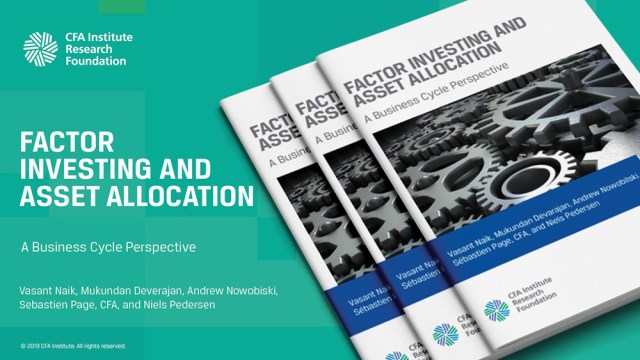[ad_1]
Strategic asset allocation (SAA) determines long-run exposure to systematic risk factors. That said, current changes in monetary policy in many developed and emerging countries as well as the stage of the business cycle warrant tactical considerations.
The tactical overlay strategy should generate added value by temporarily deviating from the weights assigned in the SAA process. Let me explain.
Asset allocation dictates the expected risk and return as well as the portfolio’s cash flow pattern. Empirical analysis demonstrates that asset allocation is the key driver of variation in returns over time. In “Determinants of Portfolio Performance,” for example, Gary P. Brinson, CFA, L. Randolph Hood, CFA, and Gilbert L. Beebower conclude that asset allocation explains on average about 90% of the variation, while timing and security selection account for the rest. In another study, “Does Asset Allocation Policy Explain 40, 90, or 100 Percent of Performance?” Roger G. Ibbotson and Paul D. Kaplan, CFA, focus on the cross-sectional variation in mutual fund returns and find that asset allocation accounts for about 40% of the variation.
The message is clear: Asset allocation is important.
But when it comes to the asset allocation process, we must distinguish SAA from tactical asset allocation (TAA). In SAA, the long-run capital expectations of different asset classes are combined with an investor’s return goals, risk tolerance, and constraints. Based on this, the exposures to the permissible asset classes are determined. The outcome is a set of portfolio weights for the asset classes. This is called the strategic asset allocation or the policy portfolio.
SAA should represent the reward for bearing systematic risk, or the risk that cannot be diversified away. Put another way, the returns are derived from systematic risk exposures in the SAA. The SAA serves as a benchmark that specifies the appropriate asset mix given long-run considerations.
This stands in stark contrast to the TAA, which refers to short-term adjustments to asset-class weights based on the expected performance of those asset classes. TAA establishes active risk and, hence, active return. The underweighting or overweighting of asset classes relative to their strategic weights should add value to an investor’s portfolio. This can be regarded as an overlay strategy, according to William F. Sharpe, Peng Chen, CFA, Jerald E. Pinto, CFA, and Dennis McLeavey, CFA, in “Asset Allocation,” from Managing Investment Portfolios: A Dynamic Process.
TAA is based on the deviation of expectations from the long-term, as well as the perception of disequilibria. SAA is derived from long-term capital market expectations as described above. The TAA exploits the deviation of asset-class values from the expected long-term relationship.
TAA decisions are guided by where assets are in the business cycle as well as expected inflation, changes in central bank policy, and variation in assets’ riskiness. With respect to the former, business cycle variation plays a key role when it comes to TAA. It matters whether the current stage of the cycle is a boom phase or a recession. Once it is determined which asset class is currently in favor, the sub-asset classes can be analyzed in more detail. Valuation, economic data, and technical and sentiment variables are critical in this respect.
Tactical overlay strategies particularly provide for flexibility as the ultra-loose monetary policy in much of the world comes to an end. The loose money era led to high valuations on equity and bond markets: A common discount rate shock may be what the capital markets need for the normalization process to begin. Hence, a coherent TAA process can leverage deviations from expected long-run returns and perceived disequilibria.
As such, tactical asset allocation is a source of tracking risk with the SAA serving as the benchmark. To be sure, in “Tracking Error and Tactical Asset Allocation,” Manuel Ammann and Heinz Zimmermann show that within-asset-class active management is a greater source of risk in relation to the SAA than the TAA is. Nevertheless, the expected benefits of TAA also must be weighed against the costs of tactical adjustments.
If you liked this post, don’t forget to subscribe to the Enterprising Investor.
All posts are the opinion of the author. As such, they should not be construed as investment advice, nor do the opinions expressed necessarily reflect the views of CFA Institute or the author’s employer.
Image credit: ©Getty Images / Thomas Barwick
Professional Learning for CFA Institute Members
CFA Institute members are empowered to self-determine and self-report professional learning (PL) credits earned, including content on Enterprising Investor. Members can record credits easily using their online PL tracker.
[ad_2]
Image and article originally from blogs.cfainstitute.org. Read the original article here.



